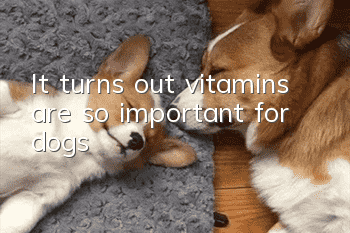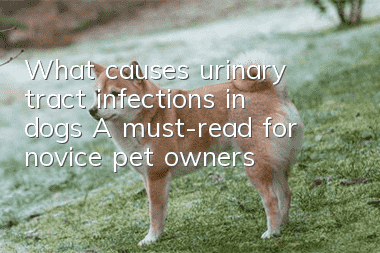It turns out vitamins are so important for dogs

Preface: This article recommends that the ingredients should be mainly provided to dogs. Cats will be introduced in another article.
Dogs and cats, like us humans, need six major nutrients to maintain normal body functions, including:
(1) Moisture
(2) Vitamins
(3) Minerals
(4) Fat
(5) Protein
(6) Carbohydrates
The main 14 essential vitamins can be divided into two major categories, including
(1) Fat solubility: A, D, E, K
(2) Water solubility: B complex & vitamin C
Once the dietary intake of vitamins is insufficient or excessive, relevant symptom warnings will appear on us and our furry children, reminding you to pay attention to supplementing with appropriate vitamins to regulate and improve the occurrence and discomfort of symptoms.
For owners who feed dry food for a long time or make their own fresh pet food, you must know a balanced intake of other ingredients to avoid nutritional deficiencies or overnutrition. Based on Lin Meifeng, associate professor of pet nutrition at National Taiwan University, and related animal nutrition research, we sorted out the functions and deficiency symptoms of the 14 vitamins needed by dogs and cats, and paired them with vitamin supplements that can be fed to dogs (the cats part will be introduced in another article) for your reference.
●Fat-soluble-
1. Vitamin A
Maintaining the normal function of epithelial tissue is also necessary for the formation of rhodopsin and bone growth. It can help promote development and increase appetite, maintain normal reproduction and lactation.
Deficiency symptoms: such as easy movement disorders, growth retardation, fatty liver, abnormal brain development, and poor immunity.
However, you should also avoid overfeeding vitamin A that can cause poisoning (50 to 500 times more than required), such as overfeeding animal livers and other rich foods.
Sources of intake: animal liver, milk and dairy products, eggs, green leafy vegetables, yellow vegetables and fruits, etc.
2. Vitamin D
Promotes the assimilation and utilization of calcium and phosphorus, which is necessary for normal bone development and the synthesis of calcium-binding proteins. In addition to nutritional deficiencies, the causes of the deficiency include long-term lack of sunlight.
Deficiency symptoms: If it occurs in puppies and cats, it is easy to have rickets, and in adult dogs and cats, it is easy to have rickets and osteoporosis.
Sources of intake: Such as marine fish and fish eggs, animal liver, egg yolks, lean meat, oats and multi-cereals.
3. Vitamin E
Is an important antioxidantIt is a chemical agent and hematopoietic function. It also affects the synthesis of proteins and regulates prostaglandins, as well as the functions of mitochondria and microsomes. It can help the body increase antibodies.
Deficiency symptoms: such as hematuria, anemia, growth retardation, loss of appetite, skeletal muscle and cardiac muscle disease, etc.
Sources of intake: sunflower seeds, spinach, almonds, green and red peppers, various edible oils
4. Vitamin K
Necessary for blood coagulation and related to bone calcification.
Deficiency symptoms: prone to bleeding or insufficient coagulation function.
Sources of intake: cauliflower, asparagus, celery, cabbage, spinach, amaranth, sea vegetables, kale, lettuce, Chinese cabbage, kiwi fruit.
●Water solubility-
1. Vitamin B1 (Thiamin)
It has the function of protecting the nervous system, and can also promote gastrointestinal motility and increase appetite. It plays the role of processing sugar and sugar (starch) in food during the digestion process, and finally produces energy; it is also required for muscle coordination and maintaining nerve conduction.
Deficiency symptoms: such as anorexia, weight loss, diarrhea, enlarged heart, neurological symptoms, etc.
Sources of intake: millet, whole wheat, oats, peanuts, pork, most vegetables, celery, milk, nuts.
2. Vitamin B2 (Riboflavin)
It is necessary for the formation of red blood cells, the production of antibodies, cellular respiration and growth. It can help body tissues such as skin, nails and hair use oxygen, remove dandruff, and assist in the absorption of iron and vitamin B6.
Deficiency symptoms: including dermatitis, insomnia, hair loss, skin hyperkeratosis, conjunctivitis, corneal degeneration, indigestion, growth retardation and unresponsiveness.
Sources of intake: fish, animal liver, eggs, dairy products, beans, whole grains and nuts, and dark green vegetables.
3. Vitamin B3 (niacin)
Helps reduce the level of harmful cholesterol in the blood and relieves mental anxiety symptoms in furry children.
Deficiency symptoms: fatigue, vomiting, back pain, weight loss, dermatitis, and neurological symptoms. In particular, severe dermatitis, diarrhea, dementia, and even death may occur in the final stages of pellagra.
Sources of intake: chicken, beef, fish (such as salmon), milk, eggs, tomatoes, leafy vegetables, broccoli, carrots, sweet potatoes, asparagus and nuts, whole grains.
4. Vitamin B5 (Pantothenic acid)
Part of coenzyme A, necessary for intermediate metabolism, helps maintain fur, fat and cholesterolRequired for sterol synthesis.
Deficiency symptoms: such as easy anorexia and poor growth; damage to motor neurons; damage to duodenal mucosal cells causing bloody stools; inflammation of the skin lesions around the eyes and anus; adrenal gland enlargement and bleeding.
Sources of intake: nuts, green leafy vegetables and brown rice.
5. Vitamin B6 (pyridoxine)
Helps bring amino acids into the intestinal mucosa, helps the endocrine system and sodium and potassium balance, promotes red blood cell production, and promotes blood vessel health. Deficiencies may cause anemia, nerve damage, epilepsy, skin problems and mouth ulcers.
Deficiency symptoms: such as easy loss of appetite, retarded growth; epileptic convulsions, limb pain, poor coordination, and spasms; inflammation of skin lesions on the feet, face, and ears; anemia or sebaceous gland abscess.
Sources of intake: White meats with the highest content (such as chicken and fish), oats, peas, peanuts, and walnuts.
6. Vitamin B12
It is a coenzyme of dehydrogenase and mutase (Mutase). It participates in the metabolism of organic sulfur together with folic acid and prevents anemia.
Deficiency symptoms: such as rough hair, kidney disease, and reduced milk production.
Source of intake: The main food sources are meat and animal offal, fish and eggs. Vitamin B12 is basically not contained in plant foods.
7. Vitamin H (Biotin)
Mainly a carrier of carbon dioxide and a prosthetic group of acetyl-CoA carboxylase, it participates in the metabolism of fatty acids and the deamination of amino acids.
Deficiency symptoms: including hair loss, baldness, dermatitis, hind limb spasm, etc.
Sources of intake: fruits, animal livers, kidneys and milk.
8. Folic acid (Folacin)
Related to the metabolism of vitamin B12, it is also required for the formation of blood cells, helping the regulation of metal ions in the body and the synthesis of vitamin C. It can build muscles, maintain body recovery and reduce developmental defects.
Deficiency symptoms: such as anemia, weight loss and poor growth; reduction of white blood cells or platelets; central nervous system and bones affected
Sources of intake: leafy vegetables, animal liver, whole grains.
(It is very important to feed your furry children an appropriate amount of vegetables and fruits on weekdays, but it is best to control the amount and choose parts with low sweetness)
9. Choline
It is a component of phospholipids and a precursor of the neurotransmitter acetylcholine.
Symptoms of deficiency include fatty liver, renal hemorrhage and necrosis, and growth retardation.
Source of intake: Chicken and chicken liver, beef and beef liver, eggs, milk, diced fillets, bananas, apples and rice.
10. Vitamin C
Vitamin C is related to collagen synthesis and blood vessel elasticity. It is an antioxidant. When vitamin C is lacking, the collagen of the tissue will become unstable and unable to function normally.
Deficiency symptoms: such as shortness of breath, joint and muscle pain, gum inflammation and bleeding, weight loss, diarrhea, liver bleeding, fat infiltration and necrosis, prolonged coagulation time, etc.
Sources of intake: various fruits, broccoli, spinach, tomatoes, lettuce, cucumbers, carrots, etc.
- Dog eating habits
- Four signs of dog health problems
- Diagnosis and treatment of canine esophagitis
- How to feed dogs during different physiological stages?
- Will the dog recognize its old owner?
- How long should you soak dog food for your puppy?
- Can dogs eat peach pulp?
- Does it matter if your dog eats durian core?
- What medicine should I use if my dog has a cold and runny nose?
- Is the injection still effective after 4 days after being bitten by a dog?



